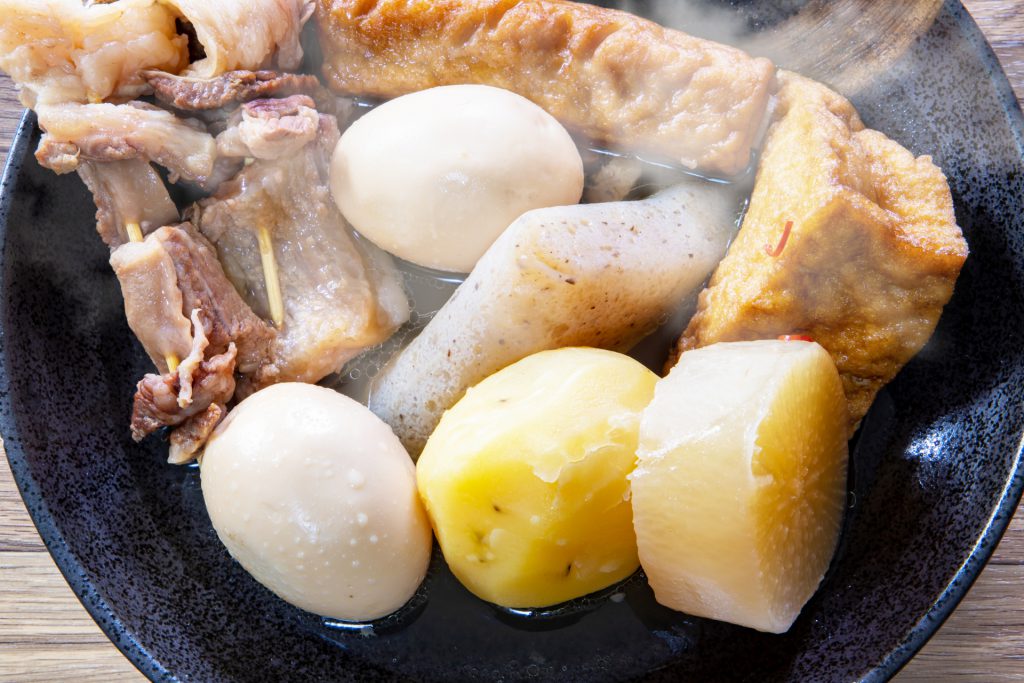Warm Up This Winter with Oden

After the beautiful colours of autumn in late November, Japan starts to get cold with freezing temperatures sweeping across the country in December and January requiring many layers just to keep warm. While the weather is usually quite nice with sunny blue skies and low humidity, it can get quite cold in many places across Japan. One of your best weapons to fight the colder weather is hot, steaming Japanese food.
What do the Japanese crave when the weather starts to turn bitterly cold? You might think a hot bowl of ramen, but what I have in mind is something even quicker than ramen that goes well with rice. It is usually right in front of your eyes near the fried food display at the register of any convenience store in Japan, inviting you to check it out with its steam and pleasant warming smell. This, my friends, is oden.

No not Odin, the Norse God of wisdom and healing but the Japanese winter delicacy oden.
Oden is a type of hot pot that consists of several ingredients such as daikon, boiled eggs, and fishcakes stewed in a lightly flavoured dashi broth.
The origins of oden lie with miso dengaku, squares of skewered tofu or konyaku (a root vegetable found in East Asia) with miso sauce. During the Edo Period (1603-1868), someone discovered that konyaku was delicious in soup and decided to throw it together with other food that was easy to sell in small stalls lined up next to yakisoba and yakitori stands.
One reason oden is so popular is due to the variety of ingredients you can try and the additional seasonings you can add to them such as miso or yuzu. You can customize your own bowl of oden to your own taste. This delightfully warming comfort food is something that you should not miss out on during winter.
Do not be afraid of ordering oden. It is pretty simple. Merely, line up at the register and say that you are ordering oden. Choose the size of the bowl, sho for small, chu for medium, or dai for large. You can choose the ingredients that you want to have in the bowl along with how much of each. Finish up by telling the clerk how much soup you want to include in the bowl.
What are the Common Ingredients Found in Oden?
Some of the most common ingredients that you will find in oden include:
Chikuwa (fried fish paste), or Chikuwabu (a mixture of steamed or fried fish paste that is made into a tube). This is a great choice for those who do not like raw fish for some healthy DHA and EPA.
Atsuage, which is fried tofu, and ganmo, which is crushed tofu mixed with vegetables and then fried.
Konyaku and shirataki, which are made from yams. Some people hate the smell, but don’t let that put you off as the health benefits are worth it. They have literally zero calories, which is great for anyone on a diet as they fill you up and help clean up the intestines and aid in digestion.
Konbu, or edible kelp, which is rich in vitamins and minerals like algin, calcium, iron, sodium, and iodine. It also helps control sugar and fat intake.
Satsumaage, fried fishcake and gobo-maki, meat wrapped around burdock root.
Kinchaku, a neat looking money bag which contains hot mochi. The name of this ingredient literally means “money pouch” in Japanese.
Daikon, Japanese radish. This is one of my favourite ingredients as it is extremely soft and wonderfully soaks up the dashi broth giving it flavour to the max!
Tamago, boiled egg. Now, this is no ordinary boiled egg. Much like the daikon, the boiled egg slowly soaks up the flavourful broth making it a favourite among many.
I need my meat! I hear you say. For any meat lovers out there, try the sausage, the beef stick, weiner-maki (sausage wrapped in satsumaage) and tsukune. Tsukune is a meat ball made from minced chicken meat. It is really good!
One item that you can only find in oden is hanpen. This soft, mild fish paste is like a savoury marshmallow, rich in DHA, EPA, calcium, and vitamin B12.
If you don’t feel like going out for oden, it is pretty easy to make at home as well. You can buy the soup in powder or concentrated liquid form from any supermarket in Japan. First, warm the soup over low heat and add your favourite ingredients. The daikon and eggs need a little bit of time to slowly cook in the broth to absorb the delicious flavour, so add them in first. The fried ingredients such as tofu and satsumaage should go in last right before eating as they don’t take very long to warm up. Slowly cook your oden for about 15 to 20 minutes.
Oden also goes great with a cold beer. The next time you see oden, don’t be shy but bold and adventurous and give it a try. You won’t be disappointed.
Do you fancy a steaming bowl of hot oden? Once you try it, you will be hooked, and I guarantee that you will be back for more every winter.
